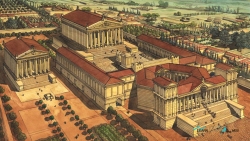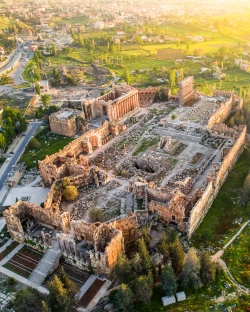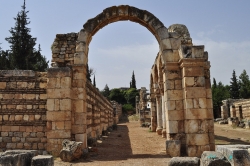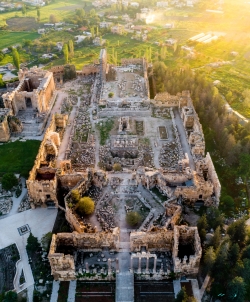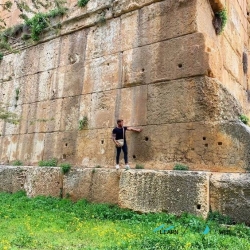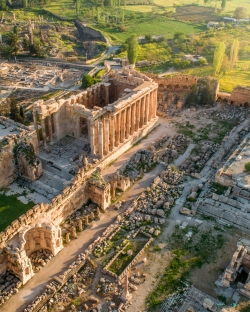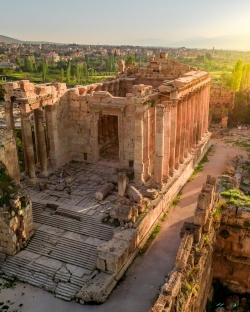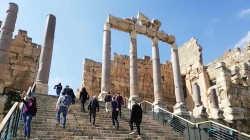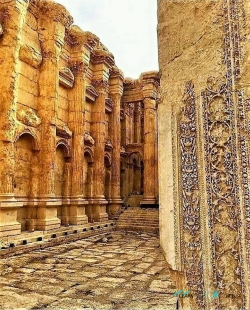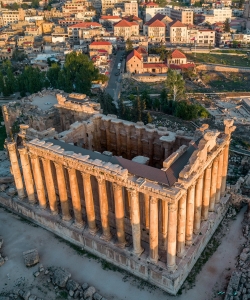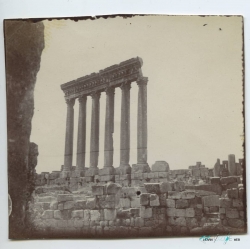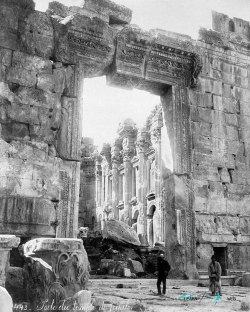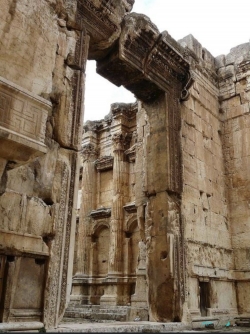Baalbek is a city located east of the Litani River in Lebanon's Beqaa Valley, about 67 km (42 mi) northeast of Beirut. It is the capital of Baalbek-Hermel Governorate. In Greek and Roman times Baalbek was also known as Heliopolis (Ἡλιούπολις Ilioúpolis, Greek for "Sun City"). In 1998 Baalbek had a population of 82,608, mostly Shia Muslims, followed by Sunni Muslims and Christians.
It is home to the Baalbek temple complex which includes two of the largest and grandest Roman temple ruins: the Temple of Bacchus and the Temple of Jupiter. It was inscribed in 1984 as an UNESCO World Heritage site.
After Alexander the Great's conquest of Persia in the 330s BC, Baalbek (under its Hellenic name Heliopolis) formed part of the Diadochi kingdoms of Egypt & Syria. It was annexed by the Romans during their eastern wars. The settlers of the Roman colony Colonia Julia Augusta Felix Heliopolitana may have arrived as early as the time of Caesar but were more probably the veterans of the 5th and 8th Legions under Augustus, during which time it hosted a Roman garrison. From 15 BC to AD 193, it formed part of the territory of Berytus. It is mentioned in Josephus, Pliny, Strabo, and Ptolemy and on coins of nearly every emperor from Nerva to Gallienus. The 1st-century Pliny did not number it among the Decapolis, the "Ten Cities" of Coelesyria, while the 2nd-century Ptolemy did. The population likely varied seasonally with market fairs and the schedules of the Indian monsoon and caravans to the coast and interior.
During Classical Antiquity, the city's temple to Baʿal Haddu was conflated first with the worship of the Greek sun god Helios and then with the Greek and Roman sky god under the name "Heliopolitan Zeus" or "Jupiter". The present Temple of Jupiter presumably replaced an earlier one using the same foundation;[e] it was constructed during the mid-1st century and probably completed around AD 60. His idol was a beardless golden god in the pose of a charioteer, with a whip raised in his right hand and a thunderbolt and stalks of grain in his left; its image appeared on local coinage and it was borne through the streets during several festivals throughout the year. Macrobius compared the rituals to those for Diva Fortuna at Antium and says the bearers were the principal citizens of the town, who prepared for their role with abstinence, chastity, and shaved heads. In bronze statuary attested from Byblos in Phoenicia and Tortosa in Spain, he was encased in a pillarlike term and surrounded (like the Greco-Persian Mithras) by busts representing the sun, moon, and five known planets. In these statues, the bust of Mercury is made particularly prominent; a marble stela at Massilia in Transalpine Gaul shows a similar arrangement but enlarges Mercury into a full figure. Local cults also revered the Baetylia, black conical stones considered sacred to Baʿal. One of these was taken to Rome by the emperor Elagabalus, a former priest "of the sun" at nearby Emesa, who erected a temple for it on the Palatine Hill. Heliopolis was a noted oracle and pilgrimage site, whence the cult spread far afield, with inscriptions to the Heliopolitan god discovered in Athens, Rome, Pannonia, Venetia, Gaul, and near the Wall in Britain. The Roman temple complex grew up from the early part of the reign of Augustus in the late 1st century BC until the rise of Christianity in the 4th century. (The 6th-century chronicles of John Malalas of Antioch, which claimed Baalbek as a "wonder of the world", credited most of the complex to the 2nd-century Antoninus Pius, but it is uncertain how reliable his account is on the point). By that time, the complex housed three temples on Tell Baalbek: one to Jupiter Heliopolitanus (Baʿal), one to Venus Heliopolitana (Ashtart), and a third to Bacchus. On a nearby hill, a fourth temple was dedicated to the third figure of the Heliopolitan Triad, Mercury (Adon or Seimios[63]). Ultimately, the site vied with Praeneste in Italy as the two largest sanctuaries in the Western world.
The emperor Trajan consulted the site's oracle twice. The first time, he requested a written reply to his sealed and unopened question; he was favorably impressed by the god's blank reply as his own paper had been empty. He then inquired whether he would return alive from his wars against Parthia and received in reply a centurion's vine staff, broken to pieces. In AD 193, Septimius Severus granted the city ius Italicum rights. His wife Julia Domna and son Caracalla toured Egypt and Syria in AD 215; inscriptions in their honour at the site may date from that occasion; Julia was a Syrian native whose father had been an Emesan priest "of the sun" like Elagabalus.
It is home to the Baalbek temple complex which includes two of the largest and grandest Roman temple ruins: the Temple of Bacchus and the Temple of Jupiter. It was inscribed in 1984 as an UNESCO World Heritage site.
After Alexander the Great's conquest of Persia in the 330s BC, Baalbek (under its Hellenic name Heliopolis) formed part of the Diadochi kingdoms of Egypt & Syria. It was annexed by the Romans during their eastern wars. The settlers of the Roman colony Colonia Julia Augusta Felix Heliopolitana may have arrived as early as the time of Caesar but were more probably the veterans of the 5th and 8th Legions under Augustus, during which time it hosted a Roman garrison. From 15 BC to AD 193, it formed part of the territory of Berytus. It is mentioned in Josephus, Pliny, Strabo, and Ptolemy and on coins of nearly every emperor from Nerva to Gallienus. The 1st-century Pliny did not number it among the Decapolis, the "Ten Cities" of Coelesyria, while the 2nd-century Ptolemy did. The population likely varied seasonally with market fairs and the schedules of the Indian monsoon and caravans to the coast and interior.
During Classical Antiquity, the city's temple to Baʿal Haddu was conflated first with the worship of the Greek sun god Helios and then with the Greek and Roman sky god under the name "Heliopolitan Zeus" or "Jupiter". The present Temple of Jupiter presumably replaced an earlier one using the same foundation;[e] it was constructed during the mid-1st century and probably completed around AD 60. His idol was a beardless golden god in the pose of a charioteer, with a whip raised in his right hand and a thunderbolt and stalks of grain in his left; its image appeared on local coinage and it was borne through the streets during several festivals throughout the year. Macrobius compared the rituals to those for Diva Fortuna at Antium and says the bearers were the principal citizens of the town, who prepared for their role with abstinence, chastity, and shaved heads. In bronze statuary attested from Byblos in Phoenicia and Tortosa in Spain, he was encased in a pillarlike term and surrounded (like the Greco-Persian Mithras) by busts representing the sun, moon, and five known planets. In these statues, the bust of Mercury is made particularly prominent; a marble stela at Massilia in Transalpine Gaul shows a similar arrangement but enlarges Mercury into a full figure. Local cults also revered the Baetylia, black conical stones considered sacred to Baʿal. One of these was taken to Rome by the emperor Elagabalus, a former priest "of the sun" at nearby Emesa, who erected a temple for it on the Palatine Hill. Heliopolis was a noted oracle and pilgrimage site, whence the cult spread far afield, with inscriptions to the Heliopolitan god discovered in Athens, Rome, Pannonia, Venetia, Gaul, and near the Wall in Britain. The Roman temple complex grew up from the early part of the reign of Augustus in the late 1st century BC until the rise of Christianity in the 4th century. (The 6th-century chronicles of John Malalas of Antioch, which claimed Baalbek as a "wonder of the world", credited most of the complex to the 2nd-century Antoninus Pius, but it is uncertain how reliable his account is on the point). By that time, the complex housed three temples on Tell Baalbek: one to Jupiter Heliopolitanus (Baʿal), one to Venus Heliopolitana (Ashtart), and a third to Bacchus. On a nearby hill, a fourth temple was dedicated to the third figure of the Heliopolitan Triad, Mercury (Adon or Seimios[63]). Ultimately, the site vied with Praeneste in Italy as the two largest sanctuaries in the Western world.
The emperor Trajan consulted the site's oracle twice. The first time, he requested a written reply to his sealed and unopened question; he was favorably impressed by the god's blank reply as his own paper had been empty. He then inquired whether he would return alive from his wars against Parthia and received in reply a centurion's vine staff, broken to pieces. In AD 193, Septimius Severus granted the city ius Italicum rights. His wife Julia Domna and son Caracalla toured Egypt and Syria in AD 215; inscriptions in their honour at the site may date from that occasion; Julia was a Syrian native whose father had been an Emesan priest "of the sun" like Elagabalus.



